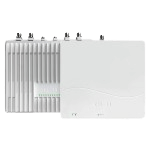Why Reliable Cell Signal is Critical to Modern Healthcare
The Hidden Backbone of Modern Medicine
From telehealth calls to real-time patient updates, connectivity in healthcare is more important than ever. As mobile devices become everyday tools for doctors, nurses, and patients alike, wireless technology in healthcare must keep pace and stay reliable.
WiFi plays a role, but it’s not always enough. A strong cellular signal is the backbone that keeps care moving, teams communicating, and patients connected when it matters most.
Take advantage of our system design and installation services. Learn more or call us for a free consultation: 1-800-969-8189.
Why Mobile Connectivity Matters More Than Ever
Modern healthcare isn’t just about what happens at the bedside, it’s about what happens across the entire network of care. And today, that network depends on mobility.
From Smartphones to Sensors, Connectivity Powers It All
In healthcare, every second counts – and so does mobile connectivity.
Strong mobile signals empower healthcare professionals to act fast and make smarter decisions. Whether it’s pulling up electronic health records (EHRs), coordinating with a specialist down the hall, or responding to an urgent update, teams rely on secure, real-time communication.
For patients, reliable cellular connectivity is peace of mind and a greater care experience. From managing telehealth appointments to portal updates, or texting loved ones during a long hospital stay, staying connected helps patients feel informed and more comfortable.
Then there’s the invisible layer: the infrastructure. Vital systems like connected monitors, wearable devices or sensors, and smart medical tools all depend on stable, uninterrupted coverage.
And the demand is only growing. According to a recent study, 98.3% of physicians use smartphones during clinical practice, highlighting the critical role of mobile devices in healthcare settings.
In short, wireless technology in healthcare isn’t optional, it’s essential to how we care for patients in today’s world. As facilities grow more connected, the need for reliable connectivity for healthcare will only continue to rise.
What Happens When Signal Drops
When cellular signal drops, so can the quality of care. In healthcare settings, even a small delay can ripple across teams, systems, and patient experiences.
Here’s what poor connectivity in healthcare can look like:
- Missed messages or dropped calls between nurses and physicians during urgent situations
- Families in waiting rooms unable to reach loved ones or get timely updates
- Telehealth sessions that freeze, cut out, or fail to connect entirely
- Delays in patient monitoring and charting, especially when mobile devices lose signal in certain areas
- Apps for translations or interpreter support won’t load, leaving patients feeling isolated or anxious
- Emergency communications that struggle to reach basements, stairwells, or remote wings
These aren’t just tech problems, they’re care problems. And while WiFi is helpful, it can’t replace the consistent, facility-wide coverage of a strong cellular network.
Why Healthcare Buildings Often Struggle with Signal
Even the most advanced healthcare facilities can struggle with signal strength. That’s because poor connectivity in healthcare often isn’t about the device—it’s about the building itself.
The Culprits Behind the Coverage Gap
Here are a few common culprits:
- Dense building materials like concrete, steel, and low-emissivity glass are great for insulation but tough on signal strength.
- Remote or rural locations may sit far from the nearest cell towers, making consistent coverage a challenge.
- Complex floor plans with underground labs, radiology suites, or thick-walled treatment areas can block or weaken signal entirely.
- Heavy tech infrastructure, such as diagnostic machines, smart monitors, or life-support machines, can interfere with cellular performance and create dead zones.
These barriers aren’t going away. But the good news? They’re fixable.
That’s where a healthcare DAS (Distributed Antenna System) comes in. Designed specifically for challenging environments like hospitals, DAS solutions bring strong, reliable signal to every corner of your facility, whether you’re in the basement or at the bedside.
Up next, we’ll explore how a healthcare DAS works and which solutions are best for your healthcare space.
How to Improve Cellular Signal in Healthcare Facilities
When cell signal struggles to reach every room, floor, and wing, a DAS steps in.
A Distributed Antenna System is a network of antennas placed throughout your building to capture and amplify cellular signal, bringing strong coverage to areas that cell towers or WiFi can’t reach. For hospitals and clinics, this means fewer dead zones and more dependable communication where it matters most.
Meet DAS: The Backbone of Reliable Healthcare Activity
There are three types of DAS:
- Passive DAS: Captures over-the-air cellular signals, amplifies them, and rebroadcasts them indoors. Requires a sliver of existing cellular signal to work. Most affordable DAS, and quickest to install.
- Active DAS: Less common in healthcare, typically used in stadiums or airports. This type does not need a signal to work, rather, it generates a cellular signal through a direct connection to the signal source. Most expensive DAS, and requires carrier approvals for deployment.
- Hybrid DAS: Improves coverage using existing cellular signals like Passive DAS, but uses digital cabling like Active DAS instead of coaxial. This setup offers stronger signal delivery and greater scalability. Installation is simple without requiring approvals.
For most medical settings, Passive DAS or Hybrid DAS solutions offer the best fit, balancing performance and practicality.
DAS Solutions Tailored for Healthcare
WilsonPro Enterprise 4330 (Passive DAS)
A great fit for mid-sized hospitals and clinics, the WilsonPro Enterprise 4330 boosts 4G and low-band 5G coverage up to 100,000 sq. ft. It works with all major U.S. carriers and helps eliminate dropped calls, slow data, and dead zones.
What sets it apart is its advanced channelization technology, which intelligently isolates and enhances individual frequency channels to maximize signal strength and quality in any environment. It also targets multiple towers at once for stronger signal and can be monitored remotely through the WilsonPro Cloud.
SureCall SignalMax Fiber DAS (Hybrid DAS)
Ideal for large or multi-story medical buildings, the SureCall SignalMax Fiber DAS covers up to 500,000 sq. ft. using fiber-optic cable for fast and reliable signal throughout the facility.
It works with all major carriers and adapts easily to any floor plan. Built-in remote monitoring tools help your team keep things running smoothly from anywhere.
Cel-Fi QUATRA 4000c (Hybrid DAS)
The Cel-Fi QUATRA 4000c is a powerful system for large healthcare spaces featuring up to +100 dB gain and up to 200,000 sq ft of coverage. It can boost signal for up to three carriers at a time and offers support for CBRS private networking.
Using digital cable rather than coaxial, it's extremely scalable without compromising signal strength or quality. Through the WAVE app, it’s easy to manage and monitor performance.
Not sure what you need? Call 1-800-470-6777 for a free consultation. Our experts will help you design the most effective and cost-efficient DAS for healthcare facilities, so you get coverage exactly where it counts.
What Reliable Signal Can Do For Your Healthcare Facility
Reliable cell signal isn’t just a tech upgrade, it’s a clinical advantage. When your facility is fully connected, everything works better:
- Better patient care: Staff can respond faster, access records instantly, and spend more time with patients, not waiting for pages or dropped calls.
- Happier patients and families: Visitors can stay connected, patients can use entertainment and translation apps, and loved ones can stay in the loop.
- Smoother workflow: Teams can coordinate with fewer delays, mobile charting becomes seamless, and communication gaps are reduced.
- Preparedness in emergencies: No one has time for dead zones when it’s life or death. A strong signal ensures alerts and calls go through everywhere.
- Future-proof infrastructure: DAS systems support the growing demand for IoT devices, telehealth expansion, and upcoming 5G innovations.
Real-World Results
Case Study #1: At Lovelace Women’s Hospital, a 175,000 sq ft facility in New Mexico, staff were dealing with dead zones, dropped calls, and frustrated patients. By installing a Cel-FI QUATRA 4000c hybrid DAS, they transformed connectivity across four floors. Internal communication improved, patient satisfaction rose, and the hospital now operates with confidence that their mobile systems won’t fail when it matters most.
“We no longer have these issues and feel confident that physicians and other providers can be reached when needed. It has given us peace of mind.”
— Hospital Representative, Lovelace Women’s Hospital
Case Study #2: At CHI St. Luke’s Health Memorial in Texas, poor signal had become a daily struggle, especially in patient areas and operating rooms. A full DAS system wasn’t in budget, so they turned to a WilsonPro commercial booster. Installed in just one week at 25% of the cost of a DAS, it immediately delivered stronger signal and faster communication—no maintenance needed.
“We noticed the impact almost immediately. It was very quick and very functional. That’s really what you need – something that is low cost, low maintenance, and just works.”
— Seann Robinson, Voice Data Network Engineer
Let’s Build Your Connectivity Plan
In healthcare, a weak signal isn’t just an inconvenience. It disrupts care, delays response times, and frustrates patients and staff alike.
Whether you manage a small clinic or a sprawling hospital, reliable connectivity in healthcare is essential to keep operations running smoothly and care teams connected at all times. A custom healthcare DAS solution can eliminate dead zones, support new technologies, and ensure your facility is ready for whatever comes next.
Ready to improve your signal? Call us today at 1-800-470-6777 for a free consultation. We’ll help you design the right solution, so you can focus on delivering care, not fighting dropped calls.
Interested in Learning More? Check Out Our Cellular Info Hub / WiFi Info Hub








